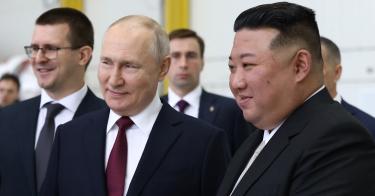In April 2010, President Obama and Russian President Medvedev signed the New Strategic Arms Reduction Treaty (New START). Under that agreement, Russia, and the United States both committed to cut strategic nuclear weapons from 2,200 warheads to 1,550, and both leaders promised to begin work on a follow-on treaty that would cut the arsenals of each country even deeper.
New START was seen as the beginning of a new era of arms control. President Obama remarked, “Going forward, we hope to pursue discussions with Russia on reducing both our strategic and tactical weapons.” Some national security professionals even anticipated that future treaties would include China.
Later that year, President Obama struck a deal with then-Senator Jon Kyl to modernize America’s nuclear arsenal, including upgrades to delivery systems, platforms, and warheads, as well as improvements to the infrastructure needed to produce the fissile material that creates a nuclear yield.
The assumption was that, with this modernization program, the nuclear arsenal would remain adequate to deal with a benign security environment. The world, however, turned out differently than expected.
>>> Russia and China Are Running in a Nuclear Arms Race While the United States Is Jogging in Place
After ratifying New START, the Russians refused to negotiate a follow-on treaty. Consequently, both strategic arsenals remained at New START levels, and both parties were free to expand their non-strategic arsenals. Meanwhile, despite repeated overtures, China remained uninterested in nuclear arms control talks.
In subsequent years, Russia’s invasions of Ukraine presented new security challenges—particularly as Moscow moved nuclear weapons into Belarus and threatened NATO allies with nuclear strikes. China’s threats to neighboring states across the western Pacific were also significant, destabilizing the region and raising concerns about a broader Pacific war.
Russia and China, of course, were expanding their nuclear arsenals and capabilities the whole time. Moscow, for example, has spent the last decade multiplying its arsenal of non-strategic nuclear weapons and is now fielding nuclear-capable theater-range cruise missiles.
So, how are things going for the U.S. nuclear modernization effort?
According to a recent Government Accountability Office (GAO) report, the Department of Energy’s ability to produce plutonium pits—the explosive material needed to create nuclear detonations—is four years behind schedule and may cost three times the original estimate.
The Sentinel missile, which is meant to replace the Minuteman III nuclear missile, is also struggling. According to GAO, “Sentinel is behind schedule due to staffing shortfalls, delays with clearance processing, and classified information technology infrastructure challenges.”
Likewise, the Columbia-class missile submarine, which is supposed to replace the Ohio-class submarine, “remains behind on producing design products—in particular, work instructions that detail how to build the submarine.”
While there are some bright spots—for example, the B-21 Raider bomber, intended to replace the B-2 bomber, is on track and Congress wisely chose to insert funding for the nuclear-capable sea-launched cruise missile into the defense budget—the grim reality is that the U.S. modernization effort is lagging.
>>> NATO’s Nuclear Posture Needs Updating
To deter increasingly aggressive and nuclear-armed China and Russia and to hedge against an uncertain future, the United States needs to build a nuclear arsenal that is larger and more diverse than what was planned on in the wake of the 2010 New START agreement.
More specifically, the United States should:
- Prepare to place more than one warhead on delivery vehicles of the ballistic missile force. The Defense Department should lay the groundwork to upload additional nuclear weapons onto the ICBM force to pre–New START levels.
- Examine the utility of a nuclear anti-ship missile. A long-range anti-ship nuclear capability would give the President more nuclear response options in the face of an adversary using nuclear weapons, thereby better deterring adversary nuclear strikes.
- Examine the feasibility of making the Sentinel ICBM road mobile. Given the expansion of adversary intercontinental nuclear capabilities and that U.S. ballistic missile submarines may no longer be undetectable, an additional second-strike capability in the form of road-mobile ICBMs would go a long way to reduce risk by creating significant targeting challenges for U.S. adversaries.
- Consider fielding road-mobile, theater-range, land-attack nuclear missiles. The ability to strike adversary targets with road-mobile theater-range weapons would help to hold adversary targets at risk, thereby complicating adversary targeting calculus.
The current U.S. nuclear arsenal was designed for a world in which Russia did not have 2,000 non-strategic nuclear weapons, did not invade its neighbors, or threaten NATO states with nuclear strikes. It was also meant for a world in which China would follow American leadership toward nuclear disarmament—not build nuclear weapons to reach parity.
To be blunt, the current U.S. arsenal is insufficient to deter our enemies. China and Russia are on the march, and if America does not build the arsenal needed to ensure peace, it will suffer the consequences.
This piece originally appeared in RealClear Defense




